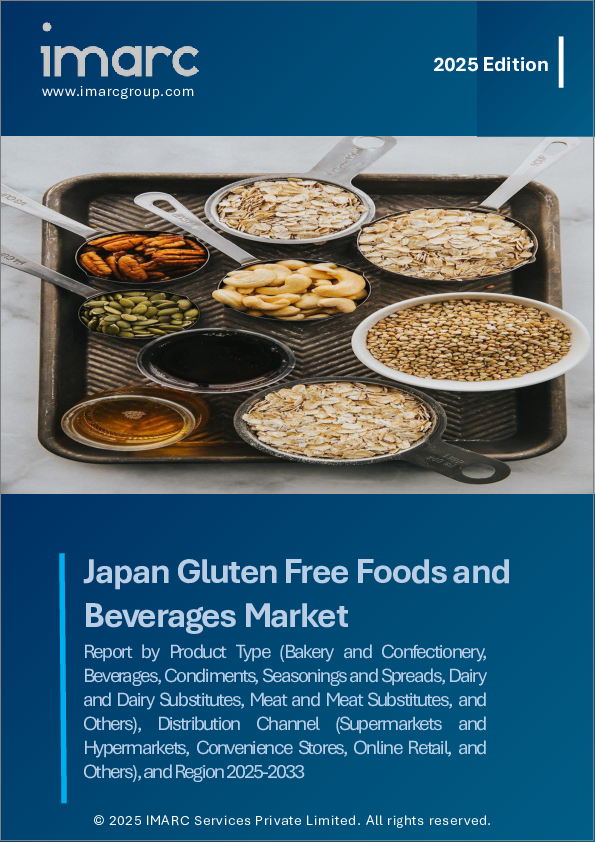|
|
市場調査レポート
商品コード
1729361
日本のグルテンフリー食品・飲料市場レポート:製品タイプ別、流通チャネル別、地域別、2025年~2033年Japan Gluten Free Foods and Beverages Market Report by Product Type, Distribution Channel, and Region 2025-2033 |
||||||
カスタマイズ可能
|
|||||||
| 日本のグルテンフリー食品・飲料市場レポート:製品タイプ別、流通チャネル別、地域別、2025年~2033年 |
|
出版日: 2025年05月01日
発行: IMARC
ページ情報: 英文 122 Pages
納期: 5~7営業日
|
全表示
- 概要
- 目次
日本のグルテンフリー食品・飲料の市場規模は2024年に8億1,770万米ドルに達しました。今後、IMARC Groupは、市場は2033年までに15億130万米ドルに達し、2025年から2033年にかけて6.46%の成長率(CAGR)を示すと予測しています。焼き菓子、パスタ、スナック、飲料など、消費者が味や利便性を犠牲にすることなくグルテンフリーのライフスタイルを採用しやすくする、より多様なグルテンフリー製品を含む革新的な製品の開発が増加していることが市場を牽引しています。
本レポートで扱う主な質問
- 日本のグルテンフリー食品・飲料市場はこれまでどのように推移し、今後どのように推移するのか?
- 日本のグルテンフリー食品・飲料市場にCOVID-19が与えた影響は?
- 日本のグルテンフリー食品・飲料市場の製品タイプ別区分は?
- 日本のグルテンフリー食品・飲料市場の流通チャネル別区分は?
- 日本のグルテンフリー食品・飲料市場のバリューチェーンにおける様々なステージとは?
- 日本のグルテンフリー食品・飲料の主な促進要因と課題は?
- 日本のグルテンフリー食品・飲料市場の構造と主要企業は?
- 日本のグルテンフリー食品・飲料市場における競合の程度は?
目次
第1章 序文
第2章 調査範囲と調査手法
- 調査の目的
- ステークホルダー
- データソース
- 市場推定
- 調査手法
第3章 エグゼクティブサマリー
第4章 日本のグルテンフリー食品・飲料市場:イントロダクション
- 概要
- 市場力学
- 業界動向
- 競合情報
第5章 日本のグルテンフリー食品・飲料市場情勢
- 過去と現在の市場動向(2019年~2024年)
- 市場予測(2025年~2033年)
第6章 日本のグルテンフリー食品・飲料市場:製品タイプ別内訳
- パン屋・菓子類
- 飲料
- 調味料、シーズニング、スプレッド
- 乳製品・乳製品代替品
- 肉・肉代替品
- その他
第7章 日本のグルテンフリー食品・飲料市場:流通チャネル別内訳
- スーパーマーケット・ハイパーマーケット
- コンビニエンスストア
- オンライン小売
- その他
第8章 日本のグルテンフリー食品・飲料市場:競合情勢
- 概要
- 市場構造
- 市場企業のポジショニング
- 主要成功戦略
- 競合ダッシュボード
- 企業評価象限
第9章 主要企業のプロファイル
第10章 日本のグルテンフリー食品・飲料市場:業界分析
- 促進要因、抑制要因、機会
- ポーターのファイブフォース分析
- バリューチェーン分析
第11章 付録
Japan gluten free foods and beverages market size reached USD 817.7 Million in 2024. Looking forward, IMARC Group expects the market to reach USD 1,501.3 Million by 2033, exhibiting a growth rate (CAGR) of 6.46% during 2025-2033. The increasing development of innovative product, including a wider variety of gluten free products, such as baked goods, pasta, snacks, and beverages, which makes it easier for consumers to adopt a gluten free lifestyle without sacrificing taste and convenience is driving the market.
Gluten free foods and beverages are products that do not contain gluten, a protein found in barley, wheat, rye, and their derivatives. These items are essential for individuals with celiac disease, gluten sensitivity, or those who choose to follow a gluten free diet for various reasons. Common gluten free foods include fresh fruits and vegetables, lean meats, fish, poultry, dairy products, eggs, etc. Alternative flours, such as coconut flour, almond flour, and tapioca flour, are also gluten free and used in baking. Gluten free packaged products like gluten free bread, pasta, crackers, and cereal are widely available. Additionally, many snacks, such as potato chips and popcorn, are often naturally free from gluten. In the beverage category, most unflavored, pure beverages like water, coffee, tea, and 100% fruit juices are naturally gluten free. However, individuals should be cautious with flavored and specialty drinks, as some may contain gluten-based additives or be cross-contaminated during processing.
Japan Gluten Free Foods and Beverages Market Trends:
Gluten free foods and beverages have experienced remarkable growth due to a confluence of market drivers. Firstly, the increasing prevalence of gluten-related disorders, including celiac disease and non-celiac gluten sensitivity in Japan, has fueled demand. Consequently, consumers diagnosed with these conditions seek safe, gluten free alternatives, propelling the market forward. Additionally, the ever-expanding health and wellness trend plays a pivotal role. As consumers become more health-conscious, they actively seek gluten free options as a perceived healthier choice. Furthermore, the growing awareness of gluten free diets as a means to alleviate gastrointestinal discomfort and improve overall well-being has spurred adoption. Moreover, the food industry's responsiveness to dietary diversity is a significant catalyst. Regional manufacturers have increasingly incorporated gluten free options into their product portfolios, catering to a broader consumer base. This, in turn, has led to improved product availability and variety, drawing in more customers. Apart from this, the influence of social media and information sharing, which improve consumer knowledge of gluten free diets through digital platforms, is expected to drive the gluten free foods and beverages market in Japan.
Japan Gluten Free Foods and Beverages Market Segmentation:
Product Type Insights:
- Bakery and Confectionery
- Beverages
- Condiments, Seasonings and Spreads
- Dairy and Dairy Substitutes
- Meat and Meat Substitutes
- Others
Distribution Channel Insights:
- Supermarkets and Hypermarkets
- Convenience Stores
- Online Retail
- Others
Competitive Landscape:
The market research report has also provided a comprehensive analysis of the competitive landscape in the market. Competitive analysis such as market structure, key player positioning, top winning strategies, competitive dashboard, and company evaluation quadrant has been covered in the report. Also, detailed profiles of all major companies have been provided.
Key Questions Answered in This Report:
- How has the Japan gluten free foods and beverages market performed so far and how will it perform in the coming years?
- What has been the impact of COVID-19 on the Japan gluten free foods and beverages market?
- What is the breakup of the Japan gluten free foods and beverages market on the basis of product type?
- What is the breakup of the Japan gluten free foods and beverages market on the basis of distribution channel?
- What are the various stages in the value chain of the Japan gluten free foods and beverages market?
- What are the key driving factors and challenges in the Japan gluten free foods and beverages?
- What is the structure of the Japan gluten free foods and beverages market and who are the key players?
- What is the degree of competition in the Japan gluten free foods and beverages market?
Table of Contents
1 Preface
2 Scope and Methodology
- 2.1 Objectives of the Study
- 2.2 Stakeholders
- 2.3 Data Sources
- 2.3.1 Primary Sources
- 2.3.2 Secondary Sources
- 2.4 Market Estimation
- 2.4.1 Bottom-Up Approach
- 2.4.2 Top-Down Approach
- 2.5 Forecasting Methodology
3 Executive Summary
4 Japan Gluten Free Foods and Beverages Market - Introduction
- 4.1 Overview
- 4.2 Market Dynamics
- 4.3 Industry Trends
- 4.4 Competitive Intelligence
5 Japan Gluten Free Foods and Beverages Market Landscape
- 5.1 Historical and Current Market Trends (2019-2024)
- 5.2 Market Forecast (2025-2033)
6 Japan Gluten Free Foods and Beverages Market - Breakup by Product Type
- 6.1 Bakery and Confectionery
- 6.1.1 Overview
- 6.1.2 Historical and Current Market Trends (2019-2024)
- 6.1.3 Market Forecast (2025-2033)
- 6.2 Beverages
- 6.2.1 Overview
- 6.2.2 Historical and Current Market Trends (2019-2024)
- 6.2.3 Market Forecast (2025-2033)
- 6.3 Condiments, Seasonings and Spreads
- 6.3.1 Overview
- 6.3.2 Historical and Current Market Trends (2019-2024)
- 6.3.3 Market Forecast (2025-2033)
- 6.4 Dairy and Dairy Substitutes
- 6.4.1 Overview
- 6.4.2 Historical and Current Market Trends (2019-2024)
- 6.4.3 Market Forecast (2025-2033)
- 6.5 Meat and Meat Substitutes
- 6.5.1 Overview
- 6.5.2 Historical and Current Market Trends (2019-2024)
- 6.5.3 Market Forecast (2025-2033)
- 6.6 Others
- 6.6.1 Historical and Current Market Trends (2019-2024)
- 6.6.2 Market Forecast (2025-2033)
7 Japan Gluten Free Foods and Beverages Market - Breakup by Distribution Channel
- 7.1 Supermarkets and Hypermarkets
- 7.1.1 Overview
- 7.1.2 Historical and Current Market Trends (2019-2024)
- 7.1.3 Market Forecast (2025-2033)
- 7.2 Convenience Stores
- 7.2.1 Overview
- 7.2.2 Historical and Current Market Trends (2019-2024)
- 7.2.3 Market Forecast (2025-2033)
- 7.3 Online Retail
- 7.3.1 Overview
- 7.3.2 Historical and Current Market Trends (2019-2024)
- 7.3.3 Market Forecast (2025-2033)
- 7.4 Others
- 7.4.1 Historical and Current Market Trends (2019-2024)
- 7.4.2 Market Forecast (2025-2033)
8 Japan Gluten Free Foods and Beverages Market - Competitive Landscape
- 8.1 Overview
- 8.2 Market Structure
- 8.3 Market Player Positioning
- 8.4 Top Winning Strategies
- 8.5 Competitive Dashboard
- 8.6 Company Evaluation Quadrant
9 Profiles of Key Players
- 9.1 Company A
- 9.1.1 Business Overview
- 9.1.2 Product Portfolio
- 9.1.3 Business Strategies
- 9.1.4 SWOT Analysis
- 9.1.5 Major News and Events
- 9.2 Company B
- 9.2.1 Business Overview
- 9.2.2 Product Portfolio
- 9.2.3 Business Strategies
- 9.2.4 SWOT Analysis
- 9.2.5 Major News and Events
- 9.3 Company C
- 9.3.1 Business Overview
- 9.3.2 Product Portfolio
- 9.3.3 Business Strategies
- 9.3.4 SWOT Analysis
- 9.3.5 Major News and Events
- 9.4 Company D
- 9.4.1 Business Overview
- 9.4.2 Product Portfolio
- 9.4.3 Business Strategies
- 9.4.4 SWOT Analysis
- 9.4.5 Major News and Events
- 9.5 Company E
- 9.5.1 Business Overview
- 9.5.2 Product Portfolio
- 9.5.3 Business Strategies
- 9.5.4 SWOT Analysis
- 9.5.5 Major News and Events
10 Japan Gluten Free Foods and Beverages Market - Industry Analysis
- 10.1 Drivers, Restraints and Opportunities
- 10.1.1 Overview
- 10.1.2 Drivers
- 10.1.3 Restraints
- 10.1.4 Opportunities
- 10.2 Porters Five Forces Analysis
- 10.2.1 Overview
- 10.2.2 Bargaining Power of Buyers
- 10.2.3 Bargaining Power of Suppliers
- 10.2.4 Degree of Competition
- 10.2.5 Threat of New Entrants
- 10.2.6 Threat of Substitutes
- 10.3 Value Chain Analysis





